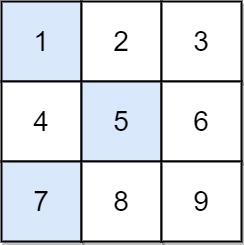LeetCode-in-Java
1289. Minimum Falling Path Sum II
Hard
Given an n x n integer matrix grid, return the minimum sum of a falling path with non-zero shifts.
A falling path with non-zero shifts is a choice of exactly one element from each row of grid such that no two elements chosen in adjacent rows are in the same column.
Example 1:

Input: arr = [[1,2,3],[4,5,6],[7,8,9]]
Output: 13
Explanation: The possible falling paths are: [1,5,9], [1,5,7], [1,6,7], [1,6,8], [2,4,8], [2,4,9], [2,6,7], [2,6,8], [3,4,8], [3,4,9], [3,5,7], [3,5,9] The falling path with the smallest sum is [1,5,7], so the answer is 13.
Example 2:
Input: grid = [[7]]
Output: 7
Constraints:
n == grid.length == grid[i].length1 <= n <= 200-99 <= grid[i][j] <= 99
Solution
public class Solution {
public int minFallingPathSum(int[][] grid) {
int n = grid[0].length;
int[] prev = new int[n];
int[] curr = new int[n];
int prevMinOne = 0;
int prevMinTwo = 0;
for (int[] ints : grid) {
int currMinOne = Integer.MAX_VALUE;
int currMinTwo = Integer.MAX_VALUE;
for (int j = 0; j < n; j++) {
int prevMin = prev[j] == prevMinOne ? prevMinTwo : prevMinOne;
curr[j] = ints[j] + prevMin;
if (curr[j] < currMinOne) {
currMinTwo = currMinOne;
currMinOne = curr[j];
} else if (curr[j] < currMinTwo) {
currMinTwo = curr[j];
}
}
prevMinOne = currMinOne;
prevMinTwo = currMinTwo;
// reuse curr array, avoid new int[] in every row
int[] temp = prev;
prev = curr;
curr = temp;
}
return prevMinOne;
}
}

